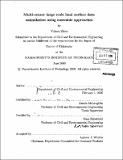| dc.contributor.advisor | Dennis McLaughlin and Dara Entekhabi. | en_US |
| dc.contributor.author | Zhou, Yuhua, Ph. D. Massachusetts Institute of Technology | en_US |
| dc.contributor.other | Massachusetts Institute of Technology. Dept. of Civil and Environmental Engineering. | en_US |
| dc.date.accessioned | 2008-02-12T16:49:36Z | |
| dc.date.available | 2008-02-12T16:49:36Z | |
| dc.date.copyright | 2006 | en_US |
| dc.date.issued | 2006 | en_US |
| dc.identifier.uri | http://dspace.mit.edu/handle/1721.1/34610 | en_US |
| dc.identifier.uri | http://hdl.handle.net/1721.1/34610 | |
| dc.description | Thesis (Ph. D.)--Massachusetts Institute of Technology, Dept. of Civil and Environmental Engineering, 2006. | en_US |
| dc.description | Includes bibliographical references (p. 223-234). | en_US |
| dc.description.abstract | One of the ensemble Kalman filter's (EnKF) attractive features in land surface applications is its ability to provide distributional information. The EnKF relies on normality approximations that improve its efficiency but can also compromise the accuracy of its distributional estimates. The effects of these approximations are evaluated by comparing the conditional marginal distributions and moments estimated by the EnKF to those obtained from an SIR particle filter, which gives exact solutions for large ensemble sizes. The results show that overall the EnKF appears to provide a good approximation for nonlinear, non-normal land surface problems. A difficulty in land data assimilation problems results from the high dimensionality of states created by spatial discretization over large computational grids. The high dimensionality can be reduced by exploiting the fact that soil moisture field may have significant spatial correlation structure especially after extensive rainfall while it may have local structure determined by soil and vegetation variability after prolonged drydown. This is confirmed by SVD of the replicate matrix produced in an ensemble forecasting experiment. Local EnKF's are suitable for problems during dry periods but give less accurate results after rainfall. | en_US |
| dc.description.abstract | (cont.) The most promising option is to develop a generalized method that reflects structural changes in the ensemble. A highly efficient ensemble multiscale filter (EnMSF) is then proposed to solve large scale nonlinear estimation problems with arbitrary uncertainties. At each prediction step realizations of the state variables are propagated. At update times, joint Gaussian distribution of states and measurements are assumed and the Predictive Efficiency method is used to identify a multiscale tree to approximate statistics of the propagated ensemble. Then a two-sweep update is performed to estimate the state variables using all the data. By controlling the tree parameters, the EnMSF can reduce sampling error while keep long range correlation in the ensemble. Applications of the EnMSF to Navier-Stokes equation and a nonlinear diffusion problem are demonstrated. Finally, the EnMSF is successfully applied to soil moisture and surface fluxes estimation over the Great Plains using synthetic multiresolution L-band passive and active microwave soil moisture measurements following HYDROS specifications. | en_US |
| dc.description.statementofresponsibility | by Yuhua Zhou. | en_US |
| dc.format.extent | 234 p. | en_US |
| dc.language.iso | eng | en_US |
| dc.publisher | Massachusetts Institute of Technology | en_US |
| dc.rights | M.I.T. theses are protected by copyright. They may be viewed from this source for any purpose, but reproduction or distribution in any format is prohibited without written permission. See provided URL for inquiries about permission. | en_US |
| dc.rights.uri | http://dspace.mit.edu/handle/1721.1/34610 | en_US |
| dc.rights.uri | http://dspace.mit.edu/handle/1721.1/7582 | |
| dc.subject | Civil and Environmental Engineering. | en_US |
| dc.title | Multi-sensor large scale land surface data assimilation using ensemble approaches | en_US |
| dc.type | Thesis | en_US |
| dc.description.degree | Ph.D. | en_US |
| dc.contributor.department | Massachusetts Institute of Technology. Department of Civil and Environmental Engineering | |
| dc.identifier.oclc | 71303942 | en_US |
